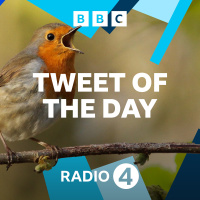Sinopsis
Discover birds through their songs and calls. Each Tweet of the Day begins with a call or song, followed by a story of fascinating ornithology inspired by the sound.
Episodios
-
Greater Honeyguide
30/10/2014 Duración: 01minTweet of the Day is the voice of birds and our relationship with them, from around the world. Miranda Krestovnikoff presents the greater honeyguide of sub-Saharan Africa. A loud repetitive "it's - here" – "it's -here" is a sound the greater honeyguide only makes to humans in an extraordinary co-operative act between humans and bird. Relatives of woodpeckers they are one of the few birds which can digest wax and also feed on the eggs, grubs and pupae of bees. A greater honeyguide knows the location of the bee colonies in its territory and is able to lead honey-hunters to them. Once it has successfully guided its helpers to a nest, it waits while the honey-hunters remove the comb. Then it moves in to snap up the grubs and wax from the opened nest. So reliable are honeyguides that the Boran people of East Africa save up to two thirds of their honey-searching time by using the bird's services and use a special loud whistle (called a fuulido) to summon their guide before a hunt.Producer : Andrew Dawes
-
Resplendent Quetzal
29/10/2014 Duración: 01minTweet of the Day is the voice of birds and our relationship with them, from around the world. Miranda Krestovnikoff presents the resplendent quetzal of Guatemala. The image of resplendent quetzals are everywhere in Guatemala, but the source of their national emblem is now confined to the cloud forests of Central America. Its beauty has long entranced people, the male quetzal a shimmering emerald-green above and scarlet below. His outstanding features are the upper tail feathers which, longer than his entire body, extend into a train almost a metre in length, twisting like metallic ribbons as he flies through the tree canopy. Historically resplendent quetzals were considered sacred to the Mayans and Aztecs for their brilliant plumage, with the lavish crown of the Aztec ruler Moctezuma the Second, containing hundreds of individual quetzal tail plumes.
-
Snow Goose
28/10/2014 Duración: 01minTweet of the Day is the voice of birds and our relationship with them, from around the world. Miranda Krestovnikoff presents the snow goose found breeding across Canada and Alaska. Although most snow geese are all-white with black wing-tips, some known as blue geese are blue-ish grey with white heads. Snow geese breed in the tundra region with goslings hatching at a time to make the most of rich supply of insect larvae and berries in the short Arctic summer. As autumn approaches though, the geese depart and head south before temperatures plummet, and the tundra becomes sealed by snow and ice. As they head for areas rich in grain and nutritious roots hundreds of thousands of snow geese fill the sky with their urgent clamour providing one of the greatest wildfowl spectacles in the world.Producer : Andrew Dawes
-
Blue-Footed Booby
27/10/2014 Duración: 01minTweet of the Day is the voice of birds and our relationship with them, from around the world.Miranda Krestovnikoff presents the Galapagos Islands blue-footed booby. Far off the Ecuador coastline the Galapagos Archipelago is home to a strange courtship dance and display of the male blue-footed booby and his large bright blue webbed feet. The intensity of the male's blue feet is viewed by the female as a sign of fitness and so he holds them up for inspection as he struts in front of her. She joins in, shadowing his actions. As the pair raise and lower their feet with exaggerated slow movements, they point their bills sky-wards while spreading their wings, raising their tails and calling.Producer : Andrew Dawes
-
King Eider
24/10/2014 Duración: 01minTweet of the Day is the voice of birds and our relationship with them, from around the world. Miranda Krestovnikoff presents the Arctic specialist the king eider duck. Relatives of the larger common eider found around the British coast, king eiders breed around the Arctic and sub-Arctic coasts of the northern hemisphere. As true marine ducks they can dive to depths of 25 metres on occasion, to feed on molluscs and marine crustaceans. The drake King Eider has colourful markings; having a black and white body with a reddish bill, surmounted by an orange-yellow shield. His cheeks are pale mint-green and his crown and nape are lavender-grey. He uses his bill pattern and head colours in a highly ritualised display to woo his mate, fluffing up his chest and issuing an amorous coo-ing call.Producer : Andrew Dawes
-
House Crow
23/10/2014 Duración: 01minTweet of the Day is the voice of birds and our relationship with them, from around the world. Miranda Krestovnikoff presents the house crow, native of southern Asia. Leggier and longer-billed than the slightly larger European carrion crow and having a charcoal grey bib and collar and raucous call, these are common birds in towns and villages from Iran through India to Thailand. As scavengers they eat almost anything, which is how they've come to live alongside us. We provide water as well as food and have introduced the birds into areas of the Middle East and Africa. Although they don't fly long distances, the crows often hop aboard ships and arrive in foreign ports. Ship-assisted house crows have the potential to spread around the globe, a beautiful example of avian exploitation of human activity.
-
Red-billed Quelea
22/10/2014 Duración: 01minTweet of the Day is the voice of birds and our relationship with them, from around the world. Miranda Krestovnikoff presents the World's most numerous bird; red billed quelea. Red-billed queleas are the most numerous birds in the world and as part of the weaverbird family sound and look like small neat sparrows. Their ability to adapt to local conditions and travel for food allows large populations of fast-breeding queleas to build up. The statistics are mind-boggling. Some flocks of red-billed quelea can comprise millions of birds which may take hours to fly past. There are probably between one and a half and ten billion birds in Africa. They breed in vast colonies; one colony in Nigeria covered one hundred and ten hectares and contained thirty one million nests.
-
Satin Bowerbird
21/10/2014 Duración: 01minTweet of the Day is the voice of birds and our relationship with them, from around the world. Miranda Krestovnikoff presents Australia's satin bowerbird. Then male is a blackish looking bird with bright purple eyes, whose plumage diffracts the light to produce an indigo sheen with a metallic lustre. He builds a U-shaped bower of sticks on the forest floor into which he hopes to lure a female. But brown twigs on a brown woodland floor aren't very eye-catching, so he jazzes up the scene with an array of objects from berries and bottle-tops to clothes-pegs and even ballpoint pens. All have one thing in common: they are blue. The male dances around his bower to attract the greenish females: often holding something blue to impress her. As he poses, he calls enticingly to advertise his prowess. Once she's made her choice, she will leave to build her nest and rear her young alone.
-
Montezuma Oropendola
20/10/2014 Duración: 01minTweet of the Day is the voice of birds and our relationship with them, from around the world. Miranda Krestovnikoff presents the Panamanian Montezuma oropendola. In a clearing in the humid rainforest in Panama a tall tree appears to be draped in hanging baskets. These are the nests of a New World blackbird, Montezuma oropendola. The male produces an ecstatic bubbling liquid call as he displays to females, reaching a crescendo whilst bowing downwards from his perch, spreading his wings and raising his tail. They weave long tubular basket-like nests from plant fibres, which they suspend in clusters from tall trees. Colonies can contain up to one hundred and seventy nests, but more usually number about thirty.Producer : Andrew Dawes
-
Echo Parakeet
17/10/2014 Duración: 01minTweet of the Day is the voice of birds and our relationship with them, from around the world.Miranda Krestovnikoff presents the echo parakeet found only in Mauritius, a bird which has brushed extinction by its wingtips. This once familiar bird of the island of Mauritius will only nest in large trees with suitable holes, few of which remain after widespread deforestation on the island. A close relative of the more adaptable ring necked parakeet found now across southern Britain where it's been introduced, by the 1980's the wild population of echo parakeets numbered around ten birds. Threatened with extinction in the wild, captive breeding and successful releases into the wild have stabilised the population to about three hundred birds.Producer : Andrew Dawes
-
Crested Lark
16/10/2014 Duración: 01minTweet of the Day is the voice of birds and our relationship with them, from around the world. Miranda Krestovnikoff presents the crested lark found from Europe across to China. The west coast of Europe is one edge of the huge range of the crested lark. Much like many larks it is a streaky brown bird but supports, as its name suggests a prominent crest of feathers on its head. Its song is delivered in a display flight over its territory as a pleasant series of liquid notes. Unlike skylarks which are rural birds, crested larks often nest in dry open places on the edge of built-up areas. Its undistinguished appearance and behaviour were cited by Francis of Assisi as signs of humility and he observed that like a humble friar, "it goes willingly along the wayside and finds a grain of corn for itself".
-
Galapagos Mockingbird
15/10/2014 Duración: 01minTweet of the Day is the voice of birds and our relationship with them, from around the world. Miranda Krestovnikoff presents a bird which intrigued Darwin, the Galapagos mockingbird. There are four species of Mockingbird in the Galapagos islands, which probably all descended from a single migrant ancestor and then subsequently evolved different adaptations to life on their separate island clusters, hence their fascination for Charles Darwin. The most widespread is the resourceful Galapagos Mockingbird. Unlike other mockingbirds which feed on nectar and seeds, the Galapagos mockingbird has adapted to its island life to steal and break into seabird eggs and even attack and kill young nestlings. They'll also ride on the backs of land iguanas to feed on ticks deep within the reptiles' skin and will boldly approach tourists for foot. They aptly demonstrate the theory of the "survival of the fittest".Producer : Andrew Dawes
-
Common Hawk Cuckoo
14/10/2014 Duración: 01minTweet of the Day is the voice of birds and our relationship with them, from around the world. Miranda Krestovnikoff presents the common hawk cuckoo from the Bengal region. The repetitive call of the common hawk-cuckoo, otherwise known as the brain-fever bird, is one of the typical sounds of rural India and on into the foothills of the Himalayas. Its name partly derives from its call sounding like "brain fever" but also what one writer called its repetition being a "damnable iteration". It looks like a bird of prey, and flies like one too, imitating the flapping glide of a sparrowhawk in the region, known as the shikra, often accompanied by mobbing small birds. Unwittingly as they mob her, birds like babblers betray their nest, into which the cuckoo will lay her egg.Producer : Andrew Dawes
-
Pied Butcherbird
13/10/2014 Duración: 01minTweet of the Day is the voice of birds and our relationship with them, from around the world.Miranda Krestovnikoff presents the virtuoso songster the pied butcherbird of Australia. Australian parks, gardens resonate to the flute like calls of a medium sized black and white bird with stout blue-grey bills, and a black hood. They earned their name 'butcherbird' from their habit of storing prey by impaling it onto thorns or in a tree crevice before feeding on it with their hooked bill. They can sing for up to twenty minutes at a time, appearing to improvise as they perform a mellifluous, but unpredictable performance which they deliver as a solo or a duet with another butcherbird. Australian composer David Lumsdaine, described its call as..... "a virtuoso of composition and improvisation".Producer : Andrew Dawes
-
Arctic Warbler
10/10/2014 Duración: 01minTweet of the Day is the voice of birds and our relationship with them, from around the world. Miranda Krestovnikoff presents the long distant migrant Arctic warbler. These classic olive-grey warblers, slightly smaller than the European robin, with a pale eye-stripe, winter in south-east Asia, but each spring fly to northern forests to breed. This can be as far as Finland, up to 13,000 kilometres away as well as Arctic and sub-Arctic Russia, Japan and even Alaska. They do this to feed on the bountiful supply of insects which proliferate during the 24-hour daylight of an Arctic summer. A few make it to Britain, the Northern Isles, but whether they finally return to Asia is not known.
-
Black Drongo
09/10/2014 Duración: 01minTweet of the Day is the voice of birds and our relationship with them, from around the world.Miranda Krestovnikoff presents the black drongo of Southern Asia. What looks a like a small crow crossed with a flycatcher is riding a cow's back in an Indian village. Black drongos are slightly smaller than European starlings, but with a much longer tail. They feed mainly on large insects: dragonflies, bees, moths and grasshoppers which they will pluck from the ground as well pursuing them in aerial sallies. Although small, these birds are famous for being fearless and will attack and dive-bomb almost any other bird, even birds of prey, which enter their territories. This aggressive behaviour has earned them the name "King Crow" and in Hindi their name is Kotwal - the policeman.Producer : Andrew Dawes
-
Variable Pitohui
08/10/2014 Duración: 01minTweet of the Day is the voice of birds and our relationship with them, from around the world. Miranda Krestovnikoff presents the poisonous variable pitohui from New Guinea. This jay sized, black-and-tan bird hides a dark secret. Named for their voice, pitohui is a representation of their song and 'variable' refers to their plumage colour which varies across their range. What is striking about this bird is that it is poisonous: its skin and feathers contain powerful neurotoxic alkaloids similar to those of South American poison-dart frogs. For the pitohui, this chemical defence is unlikely to be fatal to predators which prey on them; rather it discourages further attacks. People who've handled have suffered burning sensations in the mouth, numbness in fingers and bouts of sneezing. It is not recommended.Producer : Andrew Dawes
-
Andean Cock-of-the-Rock
07/10/2014 Duración: 01minTweet of the Day is the voice of birds and our relationship with them, from around the world.Miranda Krestovnikoff presents the Andean Cock-of-the-rock from Peru. Deep in a cloud forest a female awaits the display of her displaying males. Gathered in front of her several head-bobbing wing-waving males, these males are spectacularly dazzling; a vibrant orange head and body, with black wings and tails, yellow staring eyes, and ostentatious fan-shaped crests which can almost obscure their beaks. Male cock-of-the rocks gather at communal leks, and their performances include jumping between branches and bowing at each other whilst all the time calling loudly. Yet, for all the males' prancing and posturing, it is the female who's in control. Aware that the most dominant and fittest males will be nearest the centre of the lekking arena, it's here that she focuses her attention.Producer : Andrew Dawes
-
Hawaiian Crow
06/10/2014 Duración: 01minTweet of the Day is the voice of birds and our relationship with them, from around the world.Miranda Krestovnikoff presents the now extinct in the wild Hawaiian Crow. It's hard to imagine any crow becoming endangered, but only a hundred or so the formerly widespread Hawaiian crow survive and all of them in captivity. Also known by its Hawaiian name 'Alala' these sooty black brown crows produce a chorus of caws and screeches. Early settlers in the Hawaiian archipelago reduced their numbers, leaving the remaining populations vulnerable to introduced predators; feral pigs further reduced the fruit-laden understory plants favoured by the crow. The species was last seen in the wild in 2002. All may not be lost. A captive breeding programme overseen by San Diego Zoo is hoping to reintroduce the crows into the wild, so perhaps the Hawaiian forests will once again resound with their calls.
-
Swainson's Hawk
03/10/2014 Duración: 01minTweet of the Day is the voice of birds and our relationship with them, from around the world. Miranda Krestovnikoff presents the North American Swainson's hawk. About the size of the European buzzard, Swainson's hawks are dark-brown birds, rusty brown on the chest and white on the belly, and a familiar sight across open farmland and prairies of western North America where they soar effortlessly in search of prey. Most winter in South America, this epic round-trip of around 20,000 kilometres is probably the longest regular migration made by any American bird of prey. When they reach their wintering grounds they switch diet. In North America they feed mainly on mammals, but in South America, they gather in flocks to hunt dragonflies and grasshoppers in the vast pampas plains.Producer : Andrew Dawes














